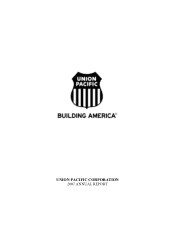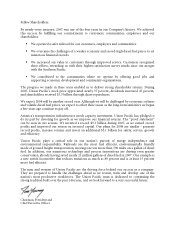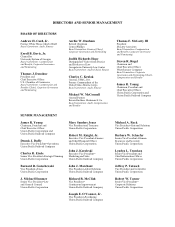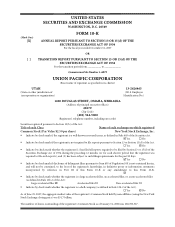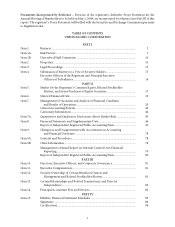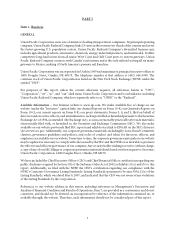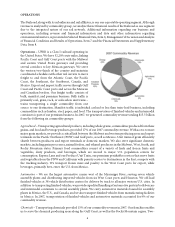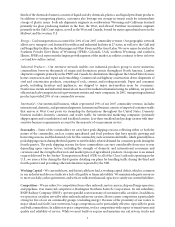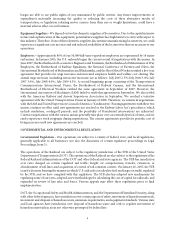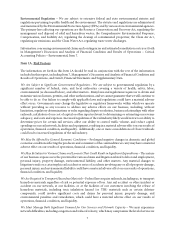Union Pacific 2007 Annual Report Download - page 9
Download and view the complete annual report
Please find page 9 of the 2007 Union Pacific annual report below. You can navigate through the pages in the report by either clicking on the pages listed below, or by using the keyword search tool below to find specific information within the annual report.5
thirds of the chemicals business consists of liquid and dry chemicals, plastics, and liquid petroleum products.
In addition to transporting plastics, customers also leverage our storage-in-transit yards for intermediate
storage of plastic resins. Soda ash shipments originate in southwestern Wyoming and California destined
primarily for glass producing markets in the East, the West, and abroad. Fertilizer movements originate
primarily in the Gulf Coast region, as well as the West and Canada, bound for major agricultural users in the
Midwest and the western U.S.
Energy – Coal transportation accounted for 20% of our 2007 commodity revenue. Our geographic network
allows us to transport coal destined for utilities and industrial facilities in 27 states, as well as to the Gulf and
rail/barge/ship facilities on the Mississippi and Ohio Rivers and the Great Lakes. We serve mines located in the
Southern Powder River Basin of Wyoming (SPRB), Colorado, Utah, southern Wyoming, and southern
Illinois. SPRB coal represents the largest growth segment of the market, as utilities continue to favor its lower
cost and low-sulfur content.
Industrial Products – Our extensive network enables our industrial products group to move numerous
commodities between thousands of origin and destination points throughout North America. Lumber
shipments originate primarily in the PNW and Canada for destinations throughout the United States for new
home construction and repair and remodeling. Commercial and highway construction drives shipments of
steel and construction products, consisting of rock, cement, and roofing materials. Paper and consumer
goods, including furniture and appliances, are shipped to major metropolitan areas for consumers.
Nonferrous metals and industrial minerals are moved for industrial manufacturing. In addition, we provide
efficient and safe transportation for government entities and waste companies. In 2007, transporting industrial
products provided 20% of our commodity revenue.
Intermodal – Our intermodal business, which represented 19% of our 2007 commodity revenue, includes
international, domestic, and premium shipments. International business consists of imported container traffic
that arrives at West Coast ports via steamship for destinations throughout the United States. Domestic
business includes domestic container and trailer traffic for intermodal marketing companies (primarily
shipper agents and consolidators) and truckload carriers. Less-than-truckload and package carriers with time-
sensitive business requirements account for the majority of our premium service.
Seasonality – Some of the commodities we carry have peak shipping seasons, reflecting either or both the
nature of the commodity, such as certain agricultural and food products that have specific growing and
harvesting seasons, and the demand cycle for the commodity, such as intermodal traffic, which generally has a
peak shipping season during the third quarter to meet holiday-related demand for consumer goods during the
fourth quarter. The peak shipping seasons for these commodities can vary considerably from year to year
depending upon various factors, including the strength of domestic and international economies and
currencies and the strength of harvests and market prices of agricultural products. In response to an annual
request delivered by the Surface Transportation Board (STB) to all of the Class I railroads operating in the
U.S., we issue a letter during the third quarter detailing our plans for handling traffic during the third and
fourth quarters and providing other information requested by the STB.
Working Capital – We currently have, and historically have had, a working capital deficit, which is common
in our industry and does not indicate a lack of liquidity or financial stability. We maintain adequate resources
to meet our daily cash requirements, and we have sufficient financial capacity to satisfy our current liabilities.
Competition – We are subject to competition from other railroads, motor carriers, ship and barge operators,
and pipelines. Our main rail competitor is Burlington Northern Santa Fe Corporation. Its rail subsidiary,
BNSF Railway Company (BNSF), operates parallel routes in many of our main traffic corridors. In addition,
we operate in corridors served by other railroads and motor carriers. Motor carrier competition is particularly
strong for five of our six commodity groups (excluding energy). Because of the proximity of our routes to
major inland and Gulf Coast waterways, barge competition can be particularly effective, especially for grain
and bulk commodities. In addition to price competition, we face competition with respect to transit times and
quality and reliability of service. While we must build or acquire and maintain our rail system, trucks and

